It looks like you're using an Ad Blocker.
Please white-list or disable AboveTopSecret.com in your ad-blocking tool.
Thank you.
Some features of ATS will be disabled while you continue to use an ad-blocker.
share:
Based on a personal interest in the subject matter, I would like to bring up the topic of Cyclopean Masonry which mainly refers to stonework in
Mycenaean architecture.
Characteristic for this architecture are massive limestone boulders that are fitted together with minimal clearance between adjacent stones and no use of mortar. This building style cannot only be seen in Greece but in other parts of the world as well.
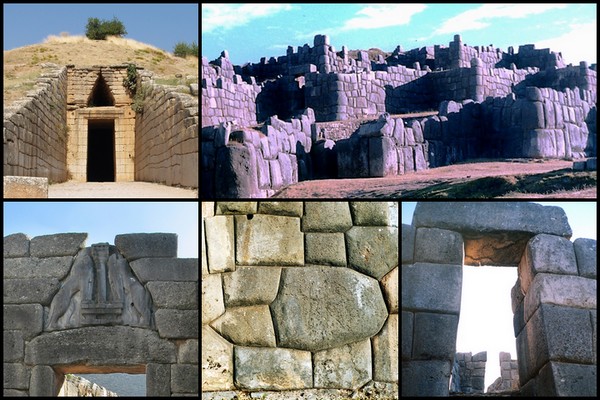
In many cases the creators of these massive stone structures are either unknown or subject to intense debates. The discussion seems to be more difficult when sites involve different periods of settlement and building activities.
In some cases the architecture displays different styles of masonry, whereas the foundation layers often refer to an earlier period while containing massive stones (up to several hundred tons) featuring precision fitting with little or no space left to adjacent stones. Layers added on top tend to consist of increasingly smaller stones with the topmost layers often using mortar.
Here goes an early definition of the various cyclopean building styles:
But let's have a look at a few examples of cyclopean structures:
1. Citadel of Mycenae, Greece
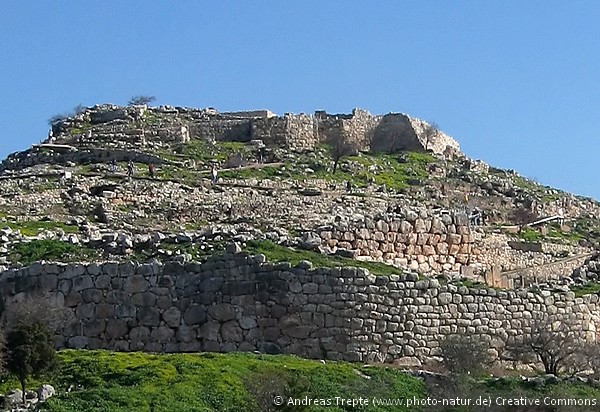
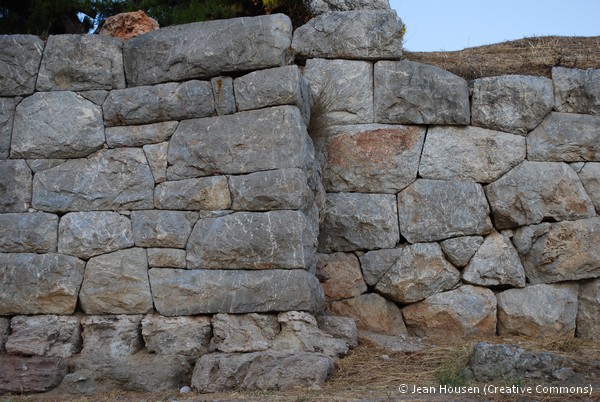
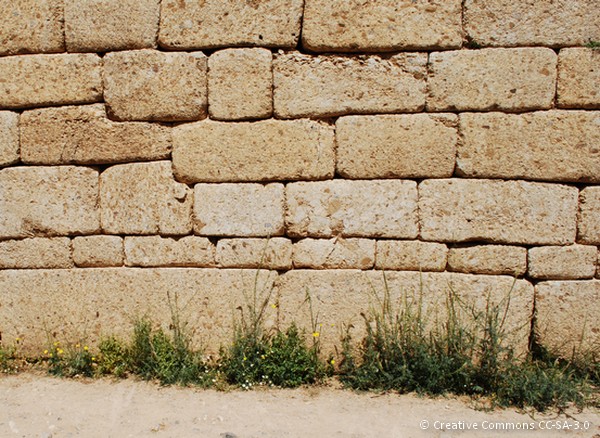
2. Treasury of Atreus, Greece
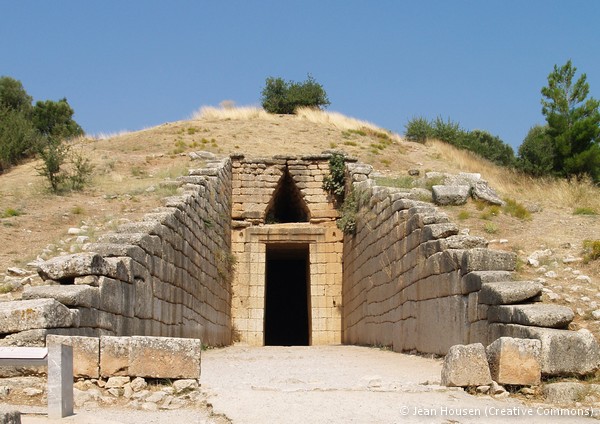
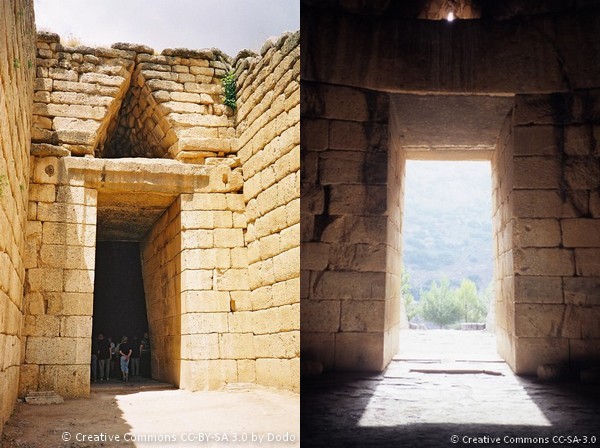
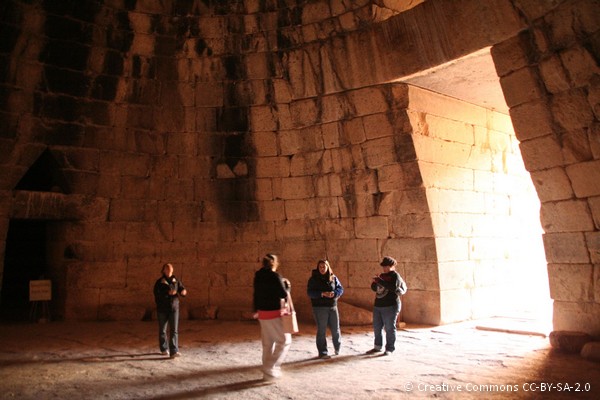 Note: The lintel stone on top of the entrance is estimated to weigh approximately 120 tons (which would roughly be the
equivalent to the weight of two M1 Abrams battle tanks, just for comparison)
Note: The lintel stone on top of the entrance is estimated to weigh approximately 120 tons (which would roughly be the
equivalent to the weight of two M1 Abrams battle tanks, just for comparison)
3. Keramikos Cemetary, Greece
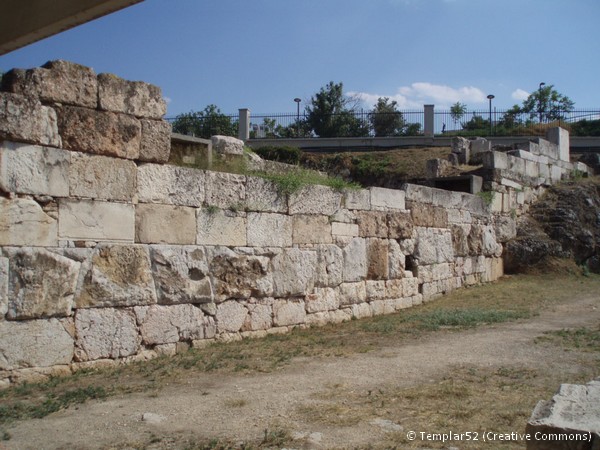
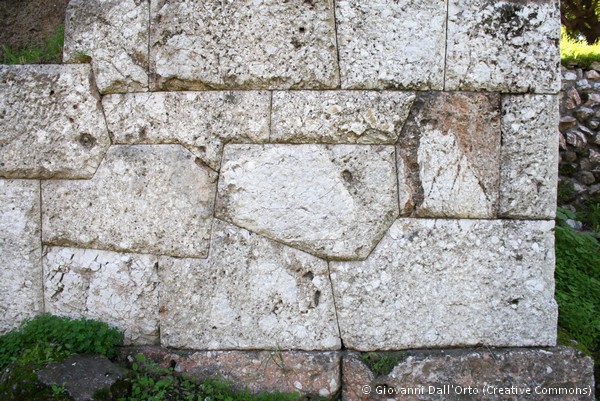
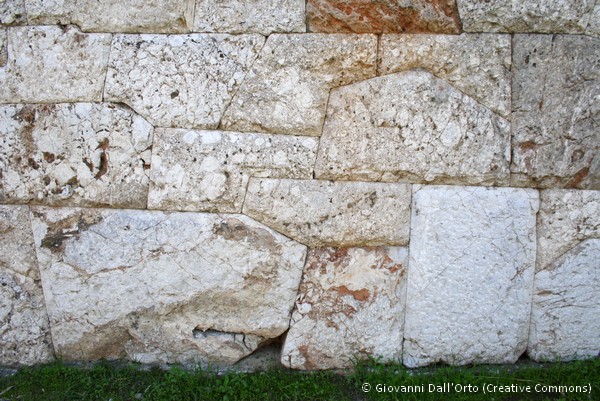
4. Messene, Greece
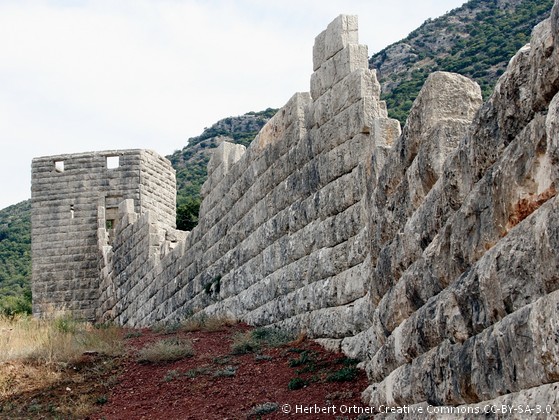
5. Sacsayhuaman, Peru

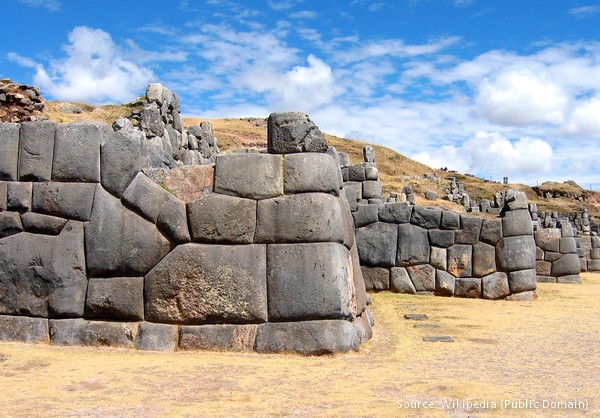
Precision Fitting even around corners(!):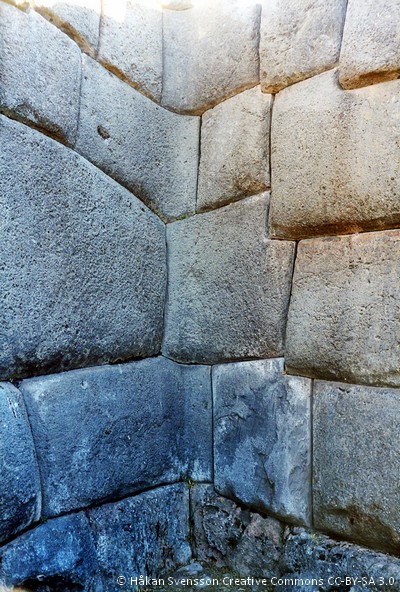
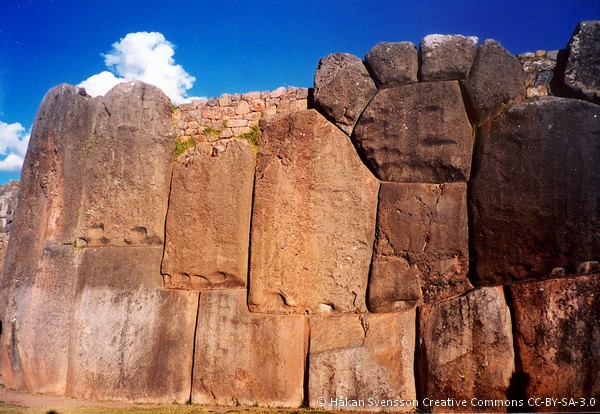
In my view, some aspects of the cyclopean building styles are so unique, that I couldn't resist thinking about a potenital connection between the sites in Greece and those of Peru, Sacsayhuaman in particular.
A comparison reveals some of the interesting similarities:
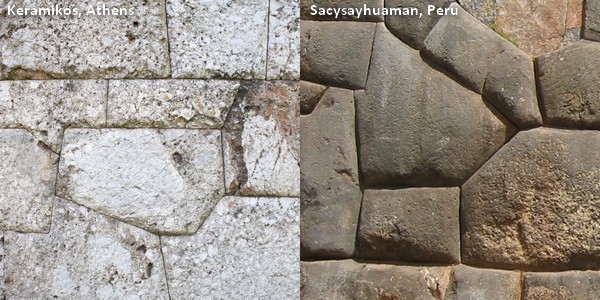
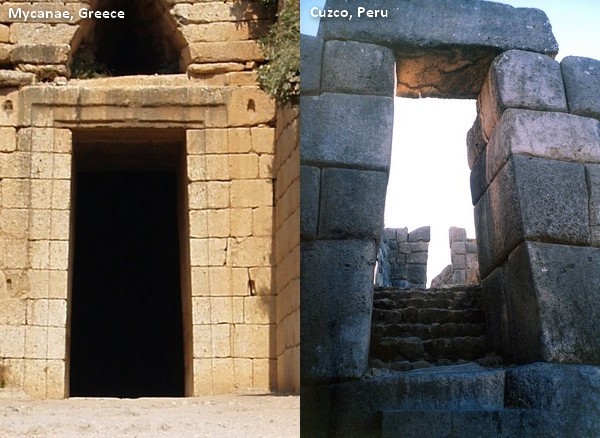

Whoever created these early structures left us an amazing cultural heritage in architecural terms but not a lot of clues as to how they achieved this incredible work. Whether this has been done with manpower, ordinary tools or something more sophisticated, I'll certainly always remain deeply impressed by the awe-inspiring sight of such masonry!
P.S.: I hope you enjoyed the comparison and I know there are already some threads touching on Incas, Peru, Mycenae etc., but I thought this might illustrate the story from a different perspective ...
Further reading: Mysteries of Ancient Greece, Cyclopean Masonry
Characteristic for this architecture are massive limestone boulders that are fitted together with minimal clearance between adjacent stones and no use of mortar. This building style cannot only be seen in Greece but in other parts of the world as well.

In many cases the creators of these massive stone structures are either unknown or subject to intense debates. The discussion seems to be more difficult when sites involve different periods of settlement and building activities.
In some cases the architecture displays different styles of masonry, whereas the foundation layers often refer to an earlier period while containing massive stones (up to several hundred tons) featuring precision fitting with little or no space left to adjacent stones. Layers added on top tend to consist of increasingly smaller stones with the topmost layers often using mortar.
Here goes an early definition of the various cyclopean building styles:
Harry Thurston Peck, writing in 1898, divided Cyclopean masonry into four categories or styles:
1. The first style (...) consists of unwrought stones of various sizes in which the gaps are, or were, filled with small stones.
2. The second is characterized by polygonal stones, which fit against each other with precision.
3. The third style includes structures in Phocis, Boeotia and Argolis. It is characterized by work made in courses and by stones of unequal size, but of the same height. This category includes the walls of Mycenae, the Lion Gate, and the Treasury of Atreus.
4. The fourth style is characterized by horizontal courses of masonry, not always of the same height, but of stones which are all rectangular. This style is common in Attica.
Source: Harry Thurston Peck, Harpers Dictionary of Classical Antiquities, 1898.
But let's have a look at a few examples of cyclopean structures:
1. Citadel of Mycenae, Greece



2. Treasury of Atreus, Greece



3. Keramikos Cemetary, Greece



4. Messene, Greece

5. Sacsayhuaman, Peru


Precision Fitting even around corners(!):


In my view, some aspects of the cyclopean building styles are so unique, that I couldn't resist thinking about a potenital connection between the sites in Greece and those of Peru, Sacsayhuaman in particular.
A comparison reveals some of the interesting similarities:



Whoever created these early structures left us an amazing cultural heritage in architecural terms but not a lot of clues as to how they achieved this incredible work. Whether this has been done with manpower, ordinary tools or something more sophisticated, I'll certainly always remain deeply impressed by the awe-inspiring sight of such masonry!
P.S.: I hope you enjoyed the comparison and I know there are already some threads touching on Incas, Peru, Mycenae etc., but I thought this might illustrate the story from a different perspective ...
Further reading: Mysteries of Ancient Greece, Cyclopean Masonry
I had a good Italian mason working for me but he liked getting his stone ready to use. I wonder if the ones who layered the blocks here were the same
way?
I'd have loved to have employees like these guys had
I'd have loved to have employees like these guys had
edit on 23-4-2013 by rickymouse because: (no reason given)
Copper wires, chisels, pulleys, and levers go a long way don't they? Not to mention doing it with only one eye. I wish one eyed giants built my house
so we wouldn't have about floating the floors and fix settling cracks.
They were certainly better builders than their
later mason counterparts.
I'd like one of the latter to put their chisel
where there mouth is..by building just one wall to the same specs.
Why? Because they can't do it.
Well not efficiently like the ancients.
Just about everywhere this masonry is found, the older it is,
the bigger and better it's built.
later mason counterparts.
I'd like one of the latter to put their chisel
where there mouth is..by building just one wall to the same specs.
Why? Because they can't do it.
Well not efficiently like the ancients.
Just about everywhere this masonry is found, the older it is,
the bigger and better it's built.
Originally posted by 1MrMarc
Copper wires, chisels, pulleys, and levers go a long way don't they? Not to mention doing it with only one eye. I wish one eyed giants built my house so we wouldn't have about floating the floors and fix settling cracks.
lol ... yeah, I guess so. But let's correct: copper wires, chisels, levers AND a lot of time on your hands, I suppose?!
And either it was one of those one-eyed monsters or people called Pelasgians, whoever they were. Supposedly, they predated the ancient greeks and at least some of the structures in Greece are occasionally said to have originated in the context of their society.
By the way: does anybody know ...
(1) How these stones could be dated or what current paradigms actually say about their age?
(2) Who these Pelasgians were (beyond of what Wikipedia says)?
... just askin'
edit on 23-4-2013 by jeep3r because: (no reason given)
reply to post by jeep3r
Lovely thread, thank you
It seems that humans spent many, many years perfecting stone technological use...then something else came along and replaced it, it became more rarefied, until the skill set died out. Mortar was used at the time that many of those buildings were constructed, but mainly as a waterproof sealant, or to create a smooth, paintable surface, it wasn't until brick built structures spread out of the Near East, that mortar was used for civic and ritual building construction...I think. And I suppose, uniformity and order were the 'style' that rulers were wanted reflected by then...
Hmmm...I am kind of wondering whether Lime was rare commodity...or rather that the process for producing it was geographically confined, making it expensive and therefore sparsely used...but that would still be irrelevant to the development of the skill that made such stonework possible....just wondering whether it was necessity or sense of the aesthetic that drove such invention. A combination of both?
Lovely thread, thank you
It seems that humans spent many, many years perfecting stone technological use...then something else came along and replaced it, it became more rarefied, until the skill set died out. Mortar was used at the time that many of those buildings were constructed, but mainly as a waterproof sealant, or to create a smooth, paintable surface, it wasn't until brick built structures spread out of the Near East, that mortar was used for civic and ritual building construction...I think. And I suppose, uniformity and order were the 'style' that rulers were wanted reflected by then...
Hmmm...I am kind of wondering whether Lime was rare commodity...or rather that the process for producing it was geographically confined, making it expensive and therefore sparsely used...but that would still be irrelevant to the development of the skill that made such stonework possible....just wondering whether it was necessity or sense of the aesthetic that drove such invention. A combination of both?
Originally posted by KilgoreTrout
reply to post by jeep3r
Lovely thread, thank you
You're welcome!
It seems that humans spent many, many years perfecting stone technological use...then something else came along and replaced it, it became more rarefied, until the skill set died out.
When looking at all the unknowns involved when interpreting the situation, I'll gladly take the above for a fact: that the skillset got lost over time, I think at least in this regard everyone should agree. Concerning the reasons ... well that's a different story, I guess. But I wish we could unravel just how this could have been achieved.
But that would still be irrelevant to the development of the skill that made such stonework possible....just wondering whether it was necessity or sense of the aesthetic that drove such invention. A combination of both?
Good questions. Both in Greece (Mycenae) and Peru (Sacsayhuaman) we're looking at fortifications and/or terraces. Usually, such constructions require a good purpose or necessity one would think, especially when going into megalithic/cyclopean dimensions. Or was it a demonstration of power/will (metaphorically: to dominate nature) by moving those rocks into place? Or was it done because of asthetics or religious ideals? It's a bit disturbing that we don't have definite answers for all these questions ...
Apart from that, I keep thinking about the pics below:

On the left is a greek example, on the right the walls of Sacsayhuaman.
Why would you build like this? It's highly peculiar, even though 'stability' seems to be a good explanation. But still: why do that, if it's so much more difficult (or isn't it?). And apart from that: Since this special way of forming/carving stones as 'polygons' can be seen in Greece and Peru (and perhaps elsewhere), could it be that these societies have been in contact? Or was it pure chance that the underlying building scheme looks similar?
Just can't get my head around that ...
edit on 23-4-2013 by jeep3r because: text
reply to post by jeep3r
Just looking at those two photographs I got a really clear mental picture...it was from one of Ian Rankin's Rebus books, I can't remember which one, but the scene is of Rebus watching a dry stone waller at work as he picks up stone after stone, turning it in his hands, before settling on the one to lay.
This is interesting...
en.wikipedia.org...
It is of course the same tradition, and although the stones are worked a little more in the examples that you supply, it is still a semi-random process where each stone laid, dictates the shape required of the next stone.
In the UK, dry stone walling is still practiced, though sparsely, and while not as refined as the examples that you provide photographs for, maintains the same principles...which leads me to wonder whether it is the purpose that dictates the stone used. Not sure about that...food for thought though
Just looking at those two photographs I got a really clear mental picture...it was from one of Ian Rankin's Rebus books, I can't remember which one, but the scene is of Rebus watching a dry stone waller at work as he picks up stone after stone, turning it in his hands, before settling on the one to lay.
This is interesting...
Some dry-stone wall constructions in north-west Europe have been dated back to the Neolithic Age. Some Cornish hedges are believed by the Guild of Cornish Hedgers to date from 5000 BC,[4] although there appears to be little dating evidence. In County Mayo, Ireland, an entire field system made from dry-stone walls, since covered in peat, have been carbon-dated to 3800 BC.
en.wikipedia.org...
It is of course the same tradition, and although the stones are worked a little more in the examples that you supply, it is still a semi-random process where each stone laid, dictates the shape required of the next stone.
In the UK, dry stone walling is still practiced, though sparsely, and while not as refined as the examples that you provide photographs for, maintains the same principles...which leads me to wonder whether it is the purpose that dictates the stone used. Not sure about that...food for thought though
reply to post by jeep3r
S&F Fascinating photos. The ancients had a technology that's been lost. They could built with megaliths because it was easy for them. So much has been lost over the millennia -- most of human history.
S&F Fascinating photos. The ancients had a technology that's been lost. They could built with megaliths because it was easy for them. So much has been lost over the millennia -- most of human history.
Originally posted by KilgoreTrout
reply to post by jeep3r
Just looking at those two photographs I got a really clear mental picture...it was from one of Ian Rankin's Rebus books, I can't remember which one, but the scene is of Rebus watching a dry stone waller at work as he picks up stone after stone, turning it in his hands, before settling on the one to lay.
Good pointer. It sometimes looks natural to me, too: you pick up a stone, analyze the edges, compare with other stones lying around and decide how to go about with minimal spacing inbetween them. I think the following image summarizes that in a good way:
I can imagine that a lot of things are possible when it comes to dry stone walling, especially when taking into account the weight & compression to hold stones in place. Yet, the specific pattern and the way they are worked (by means of skills we obviously lost) does look a bit weird or at least very unique (almost like a signature of style left behind by these old masons).
Let's have a look at some details in the stone work:
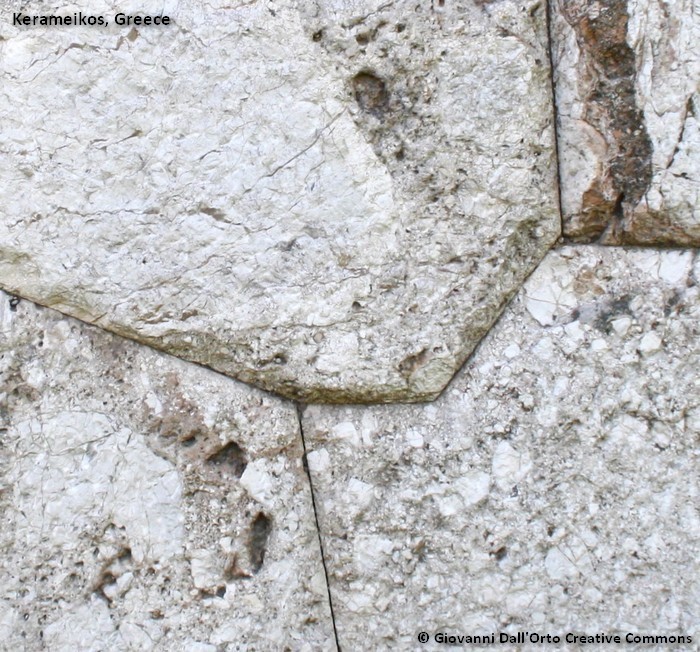
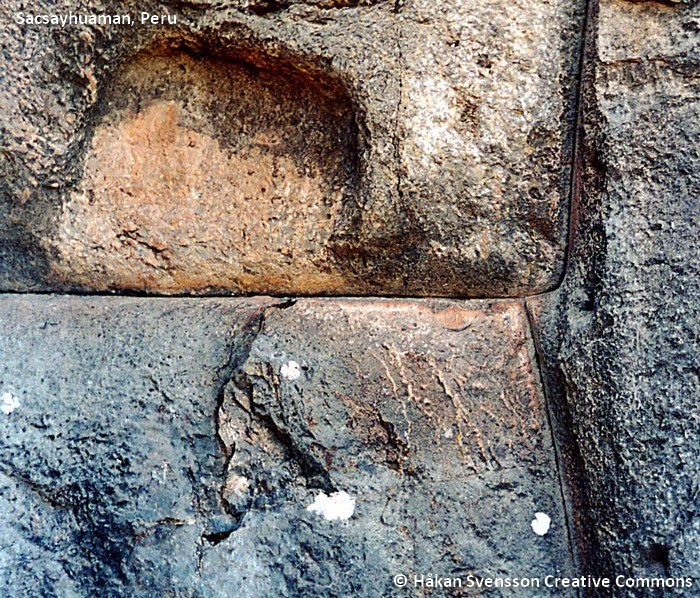
The first pic above shows wall elements along the "Sacred Way" at Kerameikos in Greece. The second pic is from Sacsayhuaman, Peru. The common elements I make out are:
- the distinct patterns of interlocking stones
- the high quality edges for precision fitting
- some sort of marks (indentations or carvings)
What I came to think is that the style does show similarities, almost as if the walls of Sacsayhuaman were an exaggerated, perfected version of the smaller walls in Greece. Did some kind of cultural exchange take place? I didn't have more time for extensive research, but I wonder if there are other sites in the world displaying similar features ...
reply to post by jeep3r
Brilliant thread and great picture's, It does beg the obvious question are we dealing with a cultural link between the early and pre classical meditaranean and the early south american culture's whom whose remains may in part though racial bias be getting wrongly attributed to later culture's and poses many more questions such as how did a city building culture that used huge masonry and obviously needed massive manpower just suddenly appear from hill farming sheep herders with all the sophistication of advanced culture, could there origin have been else were and these represent an influx of new skills and ideas after all the sea was always a hotbed of transport and trade.
Brilliant thread and great picture's, It does beg the obvious question are we dealing with a cultural link between the early and pre classical meditaranean and the early south american culture's whom whose remains may in part though racial bias be getting wrongly attributed to later culture's and poses many more questions such as how did a city building culture that used huge masonry and obviously needed massive manpower just suddenly appear from hill farming sheep herders with all the sophistication of advanced culture, could there origin have been else were and these represent an influx of new skills and ideas after all the sea was always a hotbed of transport and trade.
reply to post by jeep3r
I know, I know...you look at those photographs and it is just 'wow'...but I do think it is the same principle of technique as dry stone walling, just more developed and refined AND...planned. I think it is the latter that is at play here, and really that that is the technological breakthrough that we are looking at...planning. If we then take that concept through to the Egyptians who cut the blocks for the pyramids off-site, merely requiring them to be slot into place, the photos you represent here, are in actuality the missing link between dry stone walling and engineering with stone.
Obviously that brings us no closer to understanding the necessary technical expertise, but it does demonstrate a continuity...which is as important, I think.
In terms of 'exchange of knowledge', linking the instances of this technique over two seperate continents, personally I'd favour a single originating source, for the basic technique, combined with convergent ideology/technology, because it is the natural outcome/progression. Maybe
I know, I know...you look at those photographs and it is just 'wow'...but I do think it is the same principle of technique as dry stone walling, just more developed and refined AND...planned. I think it is the latter that is at play here, and really that that is the technological breakthrough that we are looking at...planning. If we then take that concept through to the Egyptians who cut the blocks for the pyramids off-site, merely requiring them to be slot into place, the photos you represent here, are in actuality the missing link between dry stone walling and engineering with stone.
Obviously that brings us no closer to understanding the necessary technical expertise, but it does demonstrate a continuity...which is as important, I think.
In terms of 'exchange of knowledge', linking the instances of this technique over two seperate continents, personally I'd favour a single originating source, for the basic technique, combined with convergent ideology/technology, because it is the natural outcome/progression. Maybe
Originally posted by KilgoreTrout
reply to post by jeep3r
Obviously that brings us no closer to understanding the necessary technical expertise, but it does demonstrate a continuity...which is as important, I think.
In terms of 'exchange of knowledge', linking the instances of this technique over two seperate continents, personally I'd favour a single originating source, for the basic technique, combined with convergent ideology/technology, because it is the natural outcome/progression. Maybe
You're being as objective about this as possible, which is of course good when looking at the why's and how's of this story.
In the meantime, I found at least one more important site in Greece, that also features polygonal masonry which is quite similar to that in Peru: The Oracle of the Dead (Necromanteion), Ephyra ...
Here go a few images:
And here, too, it seems that the polygonal building style preceeds everything else. The church and other buildings were obviously built using some of what already existed as a foundation. The stone finish doesn't seem as perfect as in Sacsayhuaman, but it comes quite close and they are larger than those in Kerameikos.
By the way: I like your explanation of how this style might have developed and I can imagine that planning & engineering were probably key to achieving progress in masonry. Perhaps the above examples were indeed an intermediate stage towards more advanced stone engineering. However: to some degree, the polygonal architecture seems to be superior and much more difficult to create or is that just my amateurish perspective deceiving me in this regard?
I also found an interesting link with an analysis of the Inca architecture:
Lost Civilizations in the Andes
I briefly flew over it and think they also have more questions than answers but it does go into some of the technical details and features some academic references. I'll probably read all of it later on, once I got more time on my hands ...
edit on 24-4-2013 by jeep3r because: updated URL
Originally posted by LABTECH767
reply to post by jeep3r
It does beg the obvious question are we dealing with a cultural link between the early and pre classical meditaranean and the early south american culture's whom whose remains may in part though racial bias be getting wrongly attributed to later culture's and poses many more questions (...)
Thanks, LABTECH ... indeed I suspect that:
1. There was contact between at least Greece and Peru, if not even more societies of the time
2. The method used to shape and fit the stones involves several unknowns and was lost over time
That's just a very careful doubt I cast as a typical ATS armchair observer & non-specialist in the area. But I read quite a lot about that and realized that mainstream archaeologists/scientists are often confronted with criticism and questions when they try to explain this feat as being the result of wedging & dodging using chisels.
Above all, the similarities remain quite obvious (in my view) ...
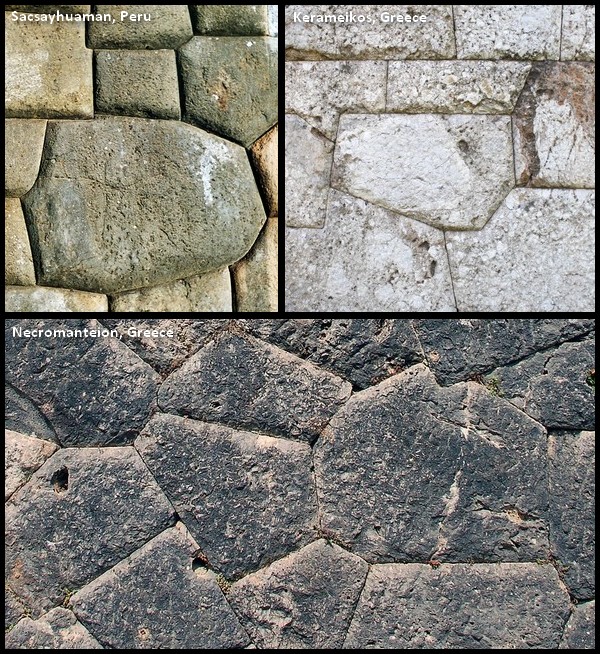
I have a theory that explains all this: "Rock Flows".
When these structures were put together, the stones didn't actually fit with these nice tight fitting seems, they were all thrown together higgle piggle.
But, over time, thousands of years later, the rocks expanded and contracted, and changed shape, filling in all the gaps between the stones. This makes the craftsmanship look a lot greater today, than it actually was back then.
We tend to think of rock as fixed shape solids. Yet we know some solids do flow like glass. Maybe all solid materials flow, given a long enough period of time. i.e. all solids look and act like liquids, when seen from a different perspective in longer time scales. This would easily explain all the marvelous stone architectures we see from the ancient cultures. The weight of the stones pressing together, supplied all the fitting force necessry to create the tight seems over time, givne a little slow time fluid flow from the rock itself.
When these structures were put together, the stones didn't actually fit with these nice tight fitting seems, they were all thrown together higgle piggle.
But, over time, thousands of years later, the rocks expanded and contracted, and changed shape, filling in all the gaps between the stones. This makes the craftsmanship look a lot greater today, than it actually was back then.
We tend to think of rock as fixed shape solids. Yet we know some solids do flow like glass. Maybe all solid materials flow, given a long enough period of time. i.e. all solids look and act like liquids, when seen from a different perspective in longer time scales. This would easily explain all the marvelous stone architectures we see from the ancient cultures. The weight of the stones pressing together, supplied all the fitting force necessry to create the tight seems over time, givne a little slow time fluid flow from the rock itself.
Nice thread, thank you.
As to how they did it there's no conclusive answer, but why is rather clear: it's the best way to build in areas with a lot of earthquake activity.
While all the fancy churches and villas from the Conquistadores were mostly destroyed by every larger earthquake, all these monuments stood the test of time. They were often used as fundaments for later architecture.
Sacsayhuaman ('sexy woman' as the Peruvians joke) is just one example in Peru (or South America), this building style is used all over.
The most famous piece must be the 'twelve angled stone', just two km from Sacsayhuaman in center Cuzco:
At Machu Picchu:
More Peru:
But I must say: the similarities you point out here with Greece are stunning.
As to how they did it there's no conclusive answer, but why is rather clear: it's the best way to build in areas with a lot of earthquake activity.
While all the fancy churches and villas from the Conquistadores were mostly destroyed by every larger earthquake, all these monuments stood the test of time. They were often used as fundaments for later architecture.
Sacsayhuaman ('sexy woman' as the Peruvians joke) is just one example in Peru (or South America), this building style is used all over.
The most famous piece must be the 'twelve angled stone', just two km from Sacsayhuaman in center Cuzco:
At Machu Picchu:
More Peru:
But I must say: the similarities you point out here with Greece are stunning.
edit on 25/4/13 by Movhisattva because: (no reason
given)
Originally posted by SQUEALER
I have a theory that explains all this: "Rock Flows".
When these structures were put together, the stones didn't actually fit with these nice tight fitting seems, they were all thrown together higgle piggle.
But, over time, thousands of years later, the rocks expanded and contracted, and changed shape, filling in all the gaps between the stones. This makes the craftsmanship look a lot greater today, than it actually was back then.
Interesting theory ... though I imagine there would still be irregular cracks somewhere, if it had actually happened like that.
And what about the faces and joints between the stones? In Sacsayhuaman the faces feature slight slopes down to where the joints are, on both sides. At least in my view, it looks as if they were intended to be exactly like that ...
Originally posted by Movhisattva
As to how they did it there's no conclusive answer, but why is rather clear: it's the best way to build in areas with a lot of earthquake activity.
While all the fancy churches and villas from the Conquistadores were mostly destroyed by every larger earthquake, all these monuments stood the test of time. They were often used as fundaments for later architecture.
Yep, earthquake-proof and essentially unmovable. Otherwise the Conquistadores would have somehow gotten rid of them a long time ago, I suppose!
Originally posted by jeep3r
Originally posted by Movhisattva
As to how they did it there's no conclusive answer, but why is rather clear: it's the best way to build in areas with a lot of earthquake activity.
Yep, earthquake-proof and essentially unmovable. Otherwise the Conquistadores would have somehow gotten rid of them a long time ago, I suppose!
Another reason why build with irregular stones. Nobody steals the building materials. When you build with regular blocks, the next generation always comes by and says, hey, these guys did all the work for us, cutting and fitting stone, lets just disassemble their work, and use the stones to build our own houses. That's what they did in Egypt. They dismanrtled the nice clean regular cut stones from the face of the Pyramids, and built houses in Cairo from them. But, with hard irregular stones, there's much less temptation. Gee, you mean I still have to cut and fit the rock? Just as well cut fresh stones from the quarry myself.
So, the irregular stone design could just be an anti-theft device.
.
new topics
-
President BIDEN's FBI Raided Donald Trump's Florida Home for OBAMA-NORTH KOREA Documents.
Political Conspiracies: 3 hours ago -
Maestro Benedetto
Literature: 5 hours ago -
Is AI Better Than the Hollywood Elite?
Movies: 5 hours ago -
Las Vegas UFO Spotting Teen Traumatized by Demon Creature in Backyard
Aliens and UFOs: 8 hours ago -
2024 Pigeon Forge Rod Run - On the Strip (Video made for you)
Automotive Discussion: 9 hours ago -
Gaza Terrorists Attack US Humanitarian Pier During Construction
Middle East Issues: 9 hours ago -
The functionality of boldening and italics is clunky and no post char limit warning?
ATS Freshman's Forum: 10 hours ago -
Meadows, Giuliani Among 11 Indicted in Arizona in Latest 2020 Election Subversion Case
Mainstream News: 11 hours ago -
Massachusetts Drag Queen Leads Young Kids in Free Palestine Chant
Social Issues and Civil Unrest: 11 hours ago
top topics
-
President BIDEN's FBI Raided Donald Trump's Florida Home for OBAMA-NORTH KOREA Documents.
Political Conspiracies: 3 hours ago, 23 flags -
Krystalnacht on today's most elite Universities?
Social Issues and Civil Unrest: 14 hours ago, 9 flags -
University of Texas Instantly Shuts Down Anti Israel Protests
Education and Media: 17 hours ago, 8 flags -
Weinstein's conviction overturned
Mainstream News: 13 hours ago, 8 flags -
Supreme Court Oral Arguments 4.25.2024 - Are PRESIDENTS IMMUNE From Later Being Prosecuted.
Above Politics: 14 hours ago, 8 flags -
Massachusetts Drag Queen Leads Young Kids in Free Palestine Chant
Social Issues and Civil Unrest: 11 hours ago, 7 flags -
Gaza Terrorists Attack US Humanitarian Pier During Construction
Middle East Issues: 9 hours ago, 7 flags -
Las Vegas UFO Spotting Teen Traumatized by Demon Creature in Backyard
Aliens and UFOs: 8 hours ago, 6 flags -
Meadows, Giuliani Among 11 Indicted in Arizona in Latest 2020 Election Subversion Case
Mainstream News: 11 hours ago, 5 flags -
2024 Pigeon Forge Rod Run - On the Strip (Video made for you)
Automotive Discussion: 9 hours ago, 4 flags
active topics
-
President BIDEN's FBI Raided Donald Trump's Florida Home for OBAMA-NORTH KOREA Documents.
Political Conspiracies • 12 • : WeMustCare -
Hate makes for strange bedfellows
US Political Madness • 47 • : 19Bones79 -
-@TH3WH17ERABB17- -Q- ---TIME TO SHOW THE WORLD--- -Part- --44--
Dissecting Disinformation • 689 • : daskakik -
University of Texas Instantly Shuts Down Anti Israel Protests
Education and Media • 265 • : Astrocometus -
Gaza Terrorists Attack US Humanitarian Pier During Construction
Middle East Issues • 27 • : ToneD -
Reason of the Existence
The Gray Area • 21 • : BingoMcGoof -
Supreme Court Oral Arguments 4.25.2024 - Are PRESIDENTS IMMUNE From Later Being Prosecuted.
Above Politics • 85 • : Sookiechacha -
Chris Christie Wishes Death Upon Trump and Ramaswamy
Politicians & People • 24 • : nugget1 -
New whistleblower Jason Sands speaks on Twitter Spaces last night.
Aliens and UFOs • 63 • : pianopraze -
SETI chief says US has no evidence for alien technology. 'And we never have'
Aliens and UFOs • 74 • : Justoneman
